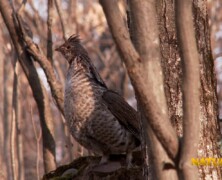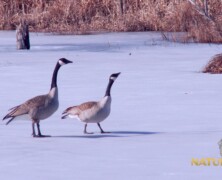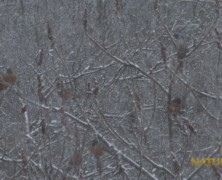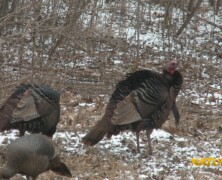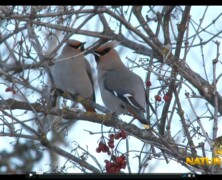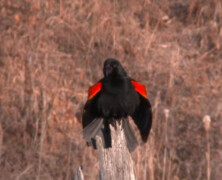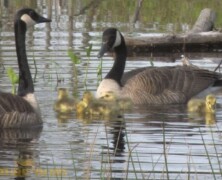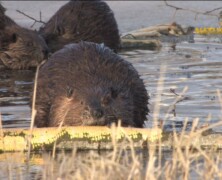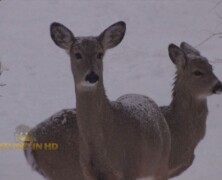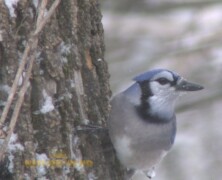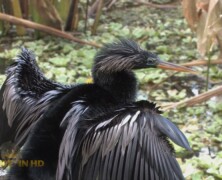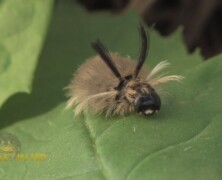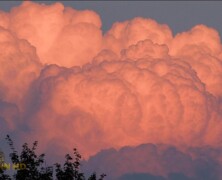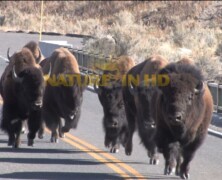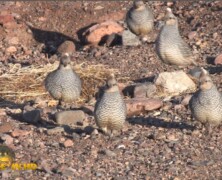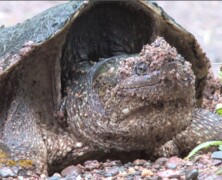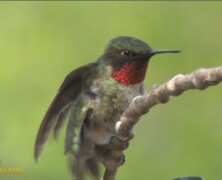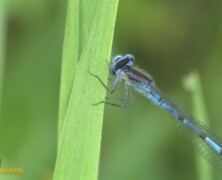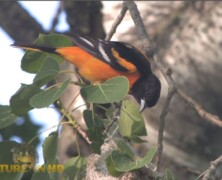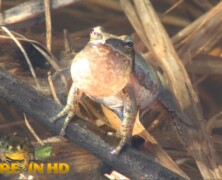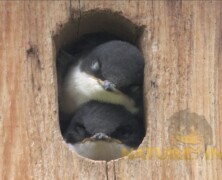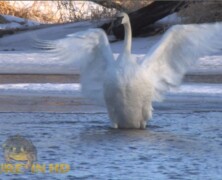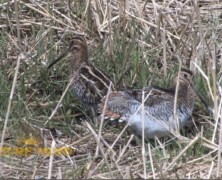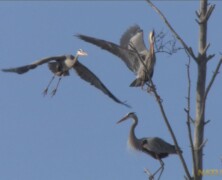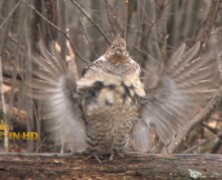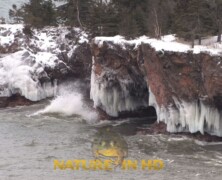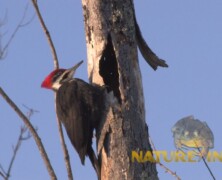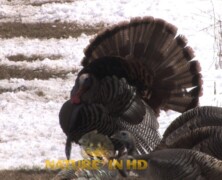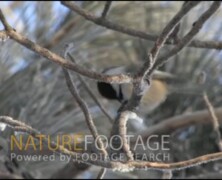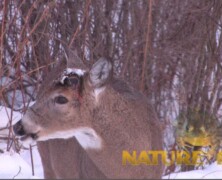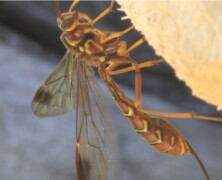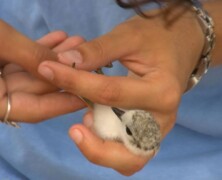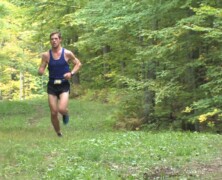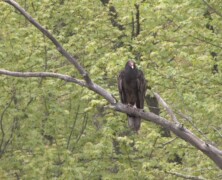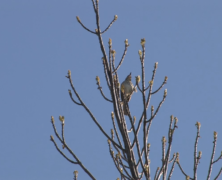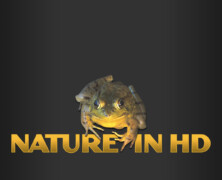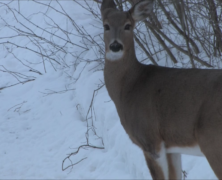Sunny spring day, perfect for this ruffed grouse to drum his wings, calling for a mate. Regrettably, he calls in a nosy neighbor instead. “Funin and Sunin” Kevin MacLeod (incompetech.com) Licensed under Creative Commons: By Attribution 3.0...
Early Spring Territoriali...
posted by Nature In HD
Almost 4 feet tall, weighing in at nearly 20 pounds, and a 5 ½ foot wingspan make this male Canadian goose and this mated pair a force to reckon with. His sights are set on the intruding duet of geese off frame. In March the geese will stake claims to beaver ponds and other suitable areas...
Spring Snowstorm Robins
posted by Nature In HD
While some American Robins do tend to stay in the Midwest all winter, most migrate south. These robins got caught in an early spring snowstorm and are making the best of it by banding together and feeding on Staghorn Sumac berries from last fall. Music: “Ambiment” by Kevin MacLeod View...
Wild Turkeys Before the S...
posted by Nature In HD
The “Storm” in this case is the competition of mating rights. These two tom wild turkeys appear to be friends now, but in a week or two there will be much competition for their lady in waiting. Music: “Light Thought” by Kevin McLeod View this selected clip in our Stock Footage...
Bohemian Waxwings Feeding...
posted by Nature In HD
This time of year, late winter, the bohemian waxwings enter our area and start feeding on dried berries that are still hanging from last fall. This is an important source of food for many birds this time of year! View this selected 4K clip in our Stock Footage Section >> View all...
A Morning On The Pond
posted by Nature In HD
Spring on the pond; Nature is returning to the northern woods. Ice is slow to go, but the ducks and geese are well on their way to carrying on another generation. The Muskrat is glad to be out from under the ice, and the Red Fox is out searching the ponds and streams looking for sustenance...
Canada Goose Spring Nesti...
posted by Nature In HD
It starts before ice-out in the north—Canada Geese arrive and plan for their spring nest. The early birds get the best nesting spots, often on a beaver lodge, like this pair. The gander defends his territory impressively, driving off other hopeful pairs of geese. Forming a lifetime bond,...
Early Spring American Bea...
posted by Nature In HD
Early spring at the beaver lodge. Anticipating the arrival of spring, this lodge is the first indicator that I watch every year. Soon, a small opening appears in the pond near the lodge, and North America’s largest rodents cautiously emerge. An often dangerous time for them, they are...
Blizzard Whitetails
posted by Nature In HD
Winter can be very difficult for whitetail deer. When snow is deep, as it is this winter, food becomes harder and harder to find. Whitetails spend their days split between finding woody browse and staying warm. With deep snow making it difficult to run, predators can also become more of a...
Snowstorm Birds
posted by Nature In HD
There’s no doubt that winter is tough on wildlife. Some adapt, some travel or migrate to warmer climes. The ones that choose to stay often face cold temperatures and deep snow. Watching from the warmth of my home, I can’t help but feel pain for my winged friends out in the cold. If I...
Anhinga
posted by Nature In HD
Clumsy yet graceful, odd-looking yet beautiful–thus we describe the Anhinga. A warm-habitat water bird, sometimes called the “Water Turkey” or “Snake Bird”, these large birds hunt prey by gliding beneath the surface of the water. There they pursue small fish– weaving...
Caterpillar Locomotion
posted by Nature In HD
A forward-moving wave best describes the locomotion of a crawling caterpillar. Eating-machines on their way to becoming butterflies and moths, the caterpillar’s undulations are quite unique among invertebrates; the gut of the caterpillar is capable of independent movement. First, the gut...
Summer Clouds
posted by Nature In HD
High in the sky–large, roiling masses of condensed air; summer cloud formations form some of the most dramatic scenes in nature. Strong updrafts lifting currents of air cause water vapor to condense and form clouds. When there is fast, powerful convection caused by atmospheric...
American Bison
posted by Nature In HD
Weighing in at one ton and standing over 5 feet at the shoulder, the American Bison, or more commonly known as the Buffalo, is the largest, heaviest herbivore in North America. Once numbering in the millions they were persecuted heavily in the 1800’s; their numbers dipping to around 500...
Scaled Quail Rendezvous
posted by Nature In HD
Sometimes you can search high and low for wildlife and rarely see it. While on a video shoot in New Mexico, however, we happened upon this group of scaled quail–literally under our noses in the parking lot. They attracted quite a crowd with their gregarious grouping and feisty...
Killdeer- New Hatchlings
posted by Nature In HD
Killdeer are one of the most familiar plovers running the grounds in North America. Named for their vocalization, they are active both day and night. They will often visit well-lit ball fields and parks in the evenings, where they are quite social and vocal. Considered shorebirds, any water...
Common Snapping Turtle
posted by Nature In HD
In Early May, American Snapping Turtles begin to rise from the depths of the ponds where they have been wintering. Called estivating, these turtles will spend the entire winter submerged in the mud in the bottom of ponds and streams. Then, seeing the light and feeling the warmth of the early...
Ruby-Throated Hummingbird...
posted by Nature In HD
When you are only two inches high, protecting your special patch of flowers for your food source becomes a demanding job; you are always on duty. Sitting nearby, you must be ever vigilant for intruders, which must be immediately chased off. North America’s only breeding hummingbirds, the...
Bluets and Ebony Jewelwin...
posted by Nature In HD
Bluets and Damselflies are small invertebrates belonging to the group Odonata. Along with their cousins, dragonflies, they are members of the oldest insect species–dating back to over 200 million years. Spending most of their lives as larva, or nymphs, they live in ponds and lakes...
Baltimore Oriole
posted by Nature In HD
After wintering in Central America, these Baltimore Orioles have selected a perfect nesting spot; high in a cottonwood tree. The Female Oriole alone weaves the nest for the brood. It can take her a week or more to construct the sturdy, tightly woven basket. Using grasses, bark, wool and even...
Meet the Spring Peeper
posted by Nature In HD
When you are only an inch long, you have special issues. Being heard above all others so you can find a mate, can be a problem. And, with wetlands diminishing, space is a challenge. Meet the Northern Spring Peeper. Called “pinkletinks” or “tinkeltoes” in some areas of the...
Tree Swallows and New Fle...
posted by Nature In HD
Tree Swallows are cavity nesters. Choice locations are holes in trees, but they readily take to man-made nest boxes. The male diligently guards the nest box from predators such as House Sparrows or Red Squirrels, while the female builds the nest and incubates. Young swallows spend most of...
Trumpeter Swans in Icy Sp...
posted by Nature In HD
Spring does not always bring early warmth. These Trumpeter Swans are spending this cold spring grouped together, patiently waiting for warm rain to open more waterways. The adults, living to 20 years or more, measure four feet high with a wingspan of seven feet. Once hunted to near...
Wilson’s Snipe
posted by Nature In HD
The Wilson’s snipe is a common shorebird that enjoys the wet, grassy areas of early spring melt-water ponds. It uses its long, flexible bill to probe the ground; searching out earthworms and small invertebrates. As seen here, during the breeding season, the snipe exploits its flashy tail...
Great Blue Heron Early Sp...
posted by Nature In HD
Even before the snow has left us completely, the Great Blue Herons arrive in the rookeries. The first males to arrive get the prime, strongest nest sites within the rookery. These same nests may be used year after year, or new ones built. They defend their territory from other males, eagerly...
Ruffed Grouse Rhythm
posted by Nature In HD
The beginning of April signals the turning point for this Ruffed Grouse. Mating season is fast approaching and he has this exact location picked out; he is ready to start advertising. By fanning his wings back and forth repetitiously, he creates a low, reverberating song that carries...
Lake Superior Ice
posted by Nature In HD
Late Winter, Lake Superior. Not a nice place sometimes. But, taken in the right frame of mind the beauty of the place comes to you. Ice palaces and rocky frozen shores can terrify the inner qualms. Cold, bitter, yet beautiful. Ride the waves of ice-ridden water as the shores of Lake Superior...
Pileated Woodpecker Drumm...
posted by Nature In HD
You just can’t beat a good hollow tree. That’s what many of nature’s subjects truly believe. This Pileated Woodpecker, the largest in North America, has found just what he’s looking for–a sturdy, yet hollow tree. He checks out the tree, then everyone around can check out...
Spring Turkeys are here!
posted by Nature In HD
Every late winter/early spring, turkeys flock here in the Northwoods. They join into groups of up to 100 birds. Moving about within the flocks, the tom turkeys position themselves for the hens benefit. Watch how this tom moves his tail strategically so each individual hen can notice him...
Late Winter Chickadee
posted by Nature In HD
Frosty mornings are still upon is. Spring is right around the corner, temperatures are beginning to warm. Add occasional moisture on top of the snow and we get beautiful frost on the pines. Birds are feeding constantly, like this chickadee. Cardinals are beginning to sing their spring...
Bucks Dropping Antlers
posted by Nature In HD
Late winter brings a dramatic change to White Tail bucks. Beginning in late December, bucks lose that year’s antler growth–usually dropping them one at a time in different locations. Occasionally, the larger bucks drop both antlers together. One will fall, and they will shake their...
Ichneumon Wasps
posted by Nature In HD
Ichneumon Wasps have over 3000 known species; these of the genus megarhyssa are two of the largest—eight to ten inches in total length. The long whip-like ovipositors on females enable the wasp to penetrate the host wood through small openings in the stump and lay eggs on the resident...
Piping Plovers Banded on ...
posted by Nature In HD
Piping Plovers, Charadrius melodus, are an endangered species of shorebird. Every year, during breeding season, groups of volunteers and National Lakeshore Rangers and staff along the shore of Lake Michigan work together caring for these nesting pairs and their chicks. Plover nest sites are...
Birkie Trail & Trek
posted by Nature In HD
The American Birkebeiner holds a trek and trail run each fall– a fun event, watch some of the highlights here. Search “Birkie Trail Run” for our clips of this event here on our website, under “stock footage” above. Music-“J. Science” by Derek...
Turkey Vultures and Black...
posted by Nature In HD
Eating carrion is a dirty job… thankfully there is help on the wing to perform this most important task in nature. The Turkey Vulture, Cathartes aura, is the most widely distributed vulture in the Americas and definitely fit for the task. They are easily recognized, as they soar with their...
Nature in HD
posted by Nature In HD
Spring is a time of constant activity in the northwoods of the United States. Animals, birds, amphibians, plants all are attempting to establish their right to bring forth new life. The constant flurry and its accompanying resonance are a marvel to the eye and ear. It’s a welcome chaos...
New Web site Launched!
posted by Nature In HD
We are pleased to announce our new Web site with our own Stock Footage solution exclusively through Footage Search. Check back often, as we’ll be posting news items from our on location video shoots and more.
Midwest Nature Footage
posted by Nature In HD
Winter; a struggle. Occasionally the sun will shine and nature ventures forth, as always, to search out warmth, sustenance. The feeble rays bring a sense of spring, soon here, warmth promised. Lives intertwine; crossing paths with nature is always a bonus during this, the hardest time of the...

